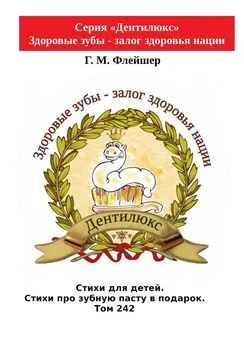Нгуэн-Ким Май Тхи - Комично, как все химично! [Почему не стоит бояться фтора в зубной пасте, тефлона на сковороде, и думать о том, что телефон на зарядке взорвется]
- Название:Комично, как все химично! [Почему не стоит бояться фтора в зубной пасте, тефлона на сковороде, и думать о том, что телефон на зарядке взорвется]
- Автор:
- Жанр:
- Издательство:Эксмо
- Год:2021
- Город:Москва
- ISBN:978-5-04-115446-2
- Рейтинг:
- Избранное:Добавить в избранное
-
Отзывы:
-
Ваша оценка:
Нгуэн-Ким Май Тхи - Комично, как все химично! [Почему не стоит бояться фтора в зубной пасте, тефлона на сковороде, и думать о том, что телефон на зарядке взорвется] краткое содержание
Комично, как все химично! [Почему не стоит бояться фтора в зубной пасте, тефлона на сковороде, и думать о том, что телефон на зарядке взорвется] - читать онлайн бесплатно ознакомительный отрывок
Интервал:
Закладка:
• McEwen, B. S. & Stellar, E. (1993). Stress and the individual: mechanisms leading to disease. Archives of internal medicine, 153(18), 2093–2101.
• Wilhelm, I., Born, J., Kudielka, B. M., Schlotz, W. & Wüst, S. (2007). Is the cortisol awakening rise a response to awakening? Psychoneuroendocrinology, 32(4), 358–366.
• Wüst, S., Wolf, J., Hellhammer, D. H., Federenko, I., Schommer, N. & Kirschbaum, C. (2000). The cortisol awakening response – normal values and confounds. Noise Health, 7, 77–85.
• Wren, M. A., Dauchy, R. T., Hanifin, J. P., Jablonski, M. R., Warfield, B., Brainard, G. C., … & Rudolf, P. (2014). Effect of different spectral transmittances through tinted animal cages on circadian metabolism and physiology in Sprague-Dawley rats. Journal of the American Association for Laboratory Animal Science, 53(1), 44–51.
• Van Geijlswijk, I. M., Korzilius, H. P. & Smits, M. G. (2010). The use of exogenous melatonin in delayed sleep phase disorder: a meta-analysis. Sleep, 33(12), 1605–1614.
• Claustrat, B. & Leston, J. (2015). Melatonin: Physiological effects in humans. Neurochirurgie, 61(2–3), 77–84.
• Zisapel, N. (2018). New perspectives on the role of melatonin in human sleep, circadian rhythms and their regulation. British journal of pharmacology.
• Lovallo, W. R., Whitsett, T. L., Al’Absi, M., Sung, B. H., Vincent, A. S. & Wilson, M. F. (2005). Caffeine stimulation of cortisol secretion across the waking hours in relation to caffeine intake levels. Psychosomatic medicine, 67(5), 734.
• Huang, R. C. (2018). The discoveries of molecular mechanisms for the circadian rhythm: The 2017 Nobel Prize in Physiology or Medicine. Biomedical journal, 41(1), 5–8.
• Stothard, E. R., McHill, A. W., Depner, C. M., Birks, B. R., Moehlman, T. M., Ritchie, H. K., … & Wright Jr, K. P. (2017). Circadian entrainment to the natural light-dark cycle across seasons and the weekend. Current Biology, 27(4), 508–513.
• Meyer-Lückel, H., Paris, S. & Ekstrand, K. (eds.) Karies: Wissenschaft und Klinische Praxis. Georg Thieme Verlag, 2012.
• Choi, A. L., et al. Developmental fluoride neurotoxicity: a systematic review and meta-analysis. Environmental health perspectives 120.10 (2012): 1362.
• Bashash, Morteza, et al. Prenatal fluoride exposure and cognitive outcomes in children at 4 and 6–12 years of age in Mexico. Environmental health perspectives 125.9 (2017): 097017.
• EFSA Panel on Dietetic Products, Nutrition, and Allergies (NDA). (2013). Scientific Opinion on Dietary Reference Values for fluoride. EFSA Journal, 11(8), 3332.
• Tremblay, M. S., Colley, R. C., Saunders, T. J., Healy, G. N. & Owen, N. (2010). Physiological and health implications of a sedentary lifestyle. Applied physiology, nutrition, and metabolism, 35(6), 725–740.
• Baddeley, B., Sornalingam, S. & Cooper, M. (2016). Sitting is the new smoking: where do we stand? Br J Gen Pract, 66(646), 258–258. (Die hier zitierte Übersetzung des englischen Originals stammt von Mai Thi Nguyen-Kim.)
• World Health Organization. (2017). Noncommunicable diseases: progress monitor 2017.
• Forouzanfar, M. H., Afshin, A., Alexander, L. T., Anderson, H. R., Bhutta, Z. A., 243.
• Biryukov, S., … & Cohen, A. J. (2016). Global, regional, and national comparative risk assessment of 79 behavioural, environmental and occupational, and metabolic risks or clusters of risks, 1990–2015: a systematic analysis for the Global Burden of Disease Study 2015. The Lancet, 388(10053), 1659–1724.
• Chau, J. Y., Bonfiglioli, C., Zhong, A., Pedisic, Z., Daley, M., McGill, B. & Bauman, A. (2017). Sitting ducks face chronic disease: an analysis of newspaper coverage of sedentary behaviour as a health issue in Australia 2000–2012. Health Promotion Journal of Australia, 28(2), 139–143.
• Ekelund, U., Steene-Johannessen, J., Brown, W. J., Fagerland, M. W., Owen, N., Powell, K. E., … & Lancet Sedentary Behaviour Working Group. (2016). Does physical activity attenuate, or even eliminate, the detrimental association of sitting time with mortality? A harmonised meta-analysis of data from more than 1 million men and women. The Lancet, 388(10051), 1302–1310.
• O’Donovan, G., Lee, I. M., Hamer, M. & Stamatakis, E. (2017). Association of» weekend warrior «and other leisure time physical activity patterns with risks for all-cause, cardiovascular disease, and cancer mortality. JAMA internal medicine, 177(3), 335–342.
• Martin, A., Fitzsimons, C., Jepson, R., Saunders, D. H., van der Ploeg, H. P., Teixeira, P. J., … & Mutrie, N. (2015). Interventions with potential to reduce sedentary time in adults: systematic review and meta-analysis. Br J Sports Med, 49(16), 1056–1063.
• Stamatakis, E., Pulsford, R. M., Brunner, E. J., Britton, A. R., Bauman, A. E., Biddle, S. J. & Hillsdon, M. (2017). Sitting behaviour is not associated with incident diabetes over 13 years: the Whitehall II cohort study. Br J Sports Med, bjsports-2016.
• Marmot, M. & Brunner, E. (2005). Cohort profile: the Whitehall II study. International journal of epidemiology, 34(2), 251–256.
• Biswas, A., Oh, P. I., Faulkner, G. E., Bajaj, R. R., Silver, M. A., Mitchell, M. S. & Alter, D. A. (2015). Sedentary time and its association with risk for disease incidence, mortality, and hospitalization in adults: a systematic review and meta-analysis. Annals of internal medicine, 162(2), 123–132.
• Van Uffelen, J. G., Wong, J., Chau, J. Y., van der Ploeg, H. P., Riphagen, I., Gilson, N. D., … & Gardiner, P. A. (2010). Occupational sitting and health risks: a systematic review. American journal of preventive medicine, 39(4), 379–388.
• Stamatakis, E., Coombs, N., Rowlands, A., Shelton, N. & Hillsdon, M. (2014). Objectively-assessed and self-reported sedentary time in relation to multiple socioeconomic status indicators among adults in England: a cross-sectional study. BMJ open, 4(11), e006034.
• Grøntved, A. & Hu, F. B. (2011). Television viewing and risk of type 2 diabetes, cardiovascular disease, and all-cause mortality: a meta-analysis. JAMA, 305(23), 2448–2455.
• Stamatakis, E., Hillsdon, M., Mishra, G., Hamer, M. & Marmot, M. G. (2009). Television viewing and other screen-based entertainment in relation to multiple socioeconomic status indicators and area deprivation: The Scottish Health Survey 2003. Journal of Epidemiology & Community Health, jech-2008.
• Hamer, M., Stamatakis, E. & Mishra, G. D. (2010). Television-and screen-based activity and mental well-being in adults. American journal of preventive medicine, 38(4), 375–380.
• Pearson, N. & Biddle, S. J. (2011). Sedentary behavior and dietary intake in children, adolescents, and adults: a systematic review. American journal of preventive medicine, 41(2), 178–188.
• Scully, M., Dixon, H. & Wakefield, M. (2009). Association between commercial television exposure and fast-food consumption among adults. Public health nutrition, 12(1), 105–110.
• Liljenquist, K., Zhong, C. B. & Galinsky, A. D. (2010). The smell of virtue: Clean scents promote reciprocity and charity. Psychological Science, 21(3), 381–383.
• Vohs, K. D., Redden, J. P. & Rahinel, R. (2013). Physical order produces healthy choices, generosity, and conventionality, whereas disorder produces creativity. Psychological Science, 24(9), 1860–1867.
• Open Science Collaboration. (2015). Estimating the reproducibility of psychological science. Science, 349(6251), aac4716.
• Price, D. D., Finniss, D. G. & Benedetti, F. (2008). A comprehensive review of the placebo effect: recent advances and current thought. Annu. Rev. Psychol., 59, 565–590.
• Jewett, D. L., Fein, G. & Greenberg, M. H. (1990). A doubleblind study of symptom provocation to determine food sensitivity. New England Journal of Medicine, 323(7), 429–433.
• Benedetti, F., Lanotte, M., Lopiano, L. & Colloca, L. (2007). When words are painful: unraveling the mechanisms of the nocebo effect. Neuroscience, 147(2), 260–271.
• Yogeshwar, R.»What’s in it for me?«Siehe: https://www. spektrum.de/kolumne/und-was-bringts-mir/1563312 oder: https://www.meta-magazin.org/2018/BI_05/05/whats-in– for-me-oder-wieso-das-grassierende-kraemerdenken-die-wissenschaft-bedroht/.
• Rohrig, B. (2015). Smartphones. ChemMatters, 11.
• Buchmann, I. (2001). Batteries in a portable world: a handbook on rechargeable batteries for non-engineers. Richmond: Cadex Electronics.
• Braga, M. H., M Subramaniyam, C., Murchison, A. J. & Goodenough, J. B. (2018). Nontraditional, Safe, High Voltage Rechargeable Cells of Long Cycle Life. Journal of the American Chemical Society, 140(20), 6343–6352.
• Asberg, M., Thoren, P., Traskman, L., Bertilsson, L. & Ringberger, V. (1976). Serotonin depression – a biochemical subgroup within the affective disorders? Science, 191(4226), 478–480.
• Song, F., Freemantle, N., Sheldon, T. A., House, A., Watson, P., Long, A. & Mason, J. (1993). Selective serotonin reuptake inhibitors: meta-analysis of effcacy and acceptability. Bmj, 306(6879), 683–687.
• Owens, M. J. & Nemerof, C. B. (1994). Role of serotonin in the pathophysiology of depression: focus on the serotonin transporter. Clinical chemistry, 40(2), 288–295.
• Whittington, C. J., Kendall, T., Fonagy, P., Cottrell, D., Cotgrove, A. & Boddington, E. (2004). Selective serotonin reuptake inhibitors in childhood depression: systematic review of published versus unpublished data. The Lancet, 363(9418), 1341–1345.
• Fergusson, D., Doucette, S., Glass, K. C., Shapiro, S., Healy, D., Hebert, P. & Hutton, B. (2005). Association between suicide attempts and selective serotonin reuptake inhibitors: systematic review of randomised controlled trials. Bmj, 330(7488), 396.
• Risch, N., Herrell, R., Lehner, T., Liang, K. Y., Eaves, L., Hoh, J., … & Merikangas, K. R. (2009). Interaction between the serotonin transporter gene (5-HTTLPR), stressful life events, and risk of depression: a meta-analysis. Jama, 301(23), 2462–2471.
• Karg, K., Burmeister, M., Shedden, K. & Sen, S. (2011). The serotonin transporter promoter variant (5-HTTLPR), stress, and depression meta-analysis revisited: evidence of genetic moderation. Archives of general psychiatry, 68(5), 444–454.
• Aguilar, F., Autrup, H., Barlow, S., Castle, L., Crebelli, R., Dekant, W., … & Gürtler, R. (2008). Assessment of the results of the study by McCann et al. (2007) on the effect of some colours and sodium benzoate on children’s behaviour. The EFSA Journal, 660, 1–54.
• McCann, D., Barrett, A., Cooper, A., Crumpler, D., Dalen, L., Grimshaw, K., … & Sonuga-Barke, E. (2007). Food additives and hyperactive behaviour in 3-year-old and 8/9-year-old children in the community: a randomised, double-blinded, placebo-controlled trial. The Lancet, 370(9598), 1560–1567.
• Schab, D. W. & Trinh, N. H. T. (2004). Do artificial food colors promote hyperactivity in children with hyperactive syndromes? A meta-analysis of double-blind placebo-controlled trials. Journal of Developmental & Behavioral Pediatrics, 25(6), 423–434.
Читать дальшеИнтервал:
Закладка:
![Обложка книги Нгуэн-Ким Май Тхи - Комично, как все химично! [Почему не стоит бояться фтора в зубной пасте, тефлона на сковороде, и думать о том, что телефон на зарядке взорвется]](/books/1060968/nguen.webp)









